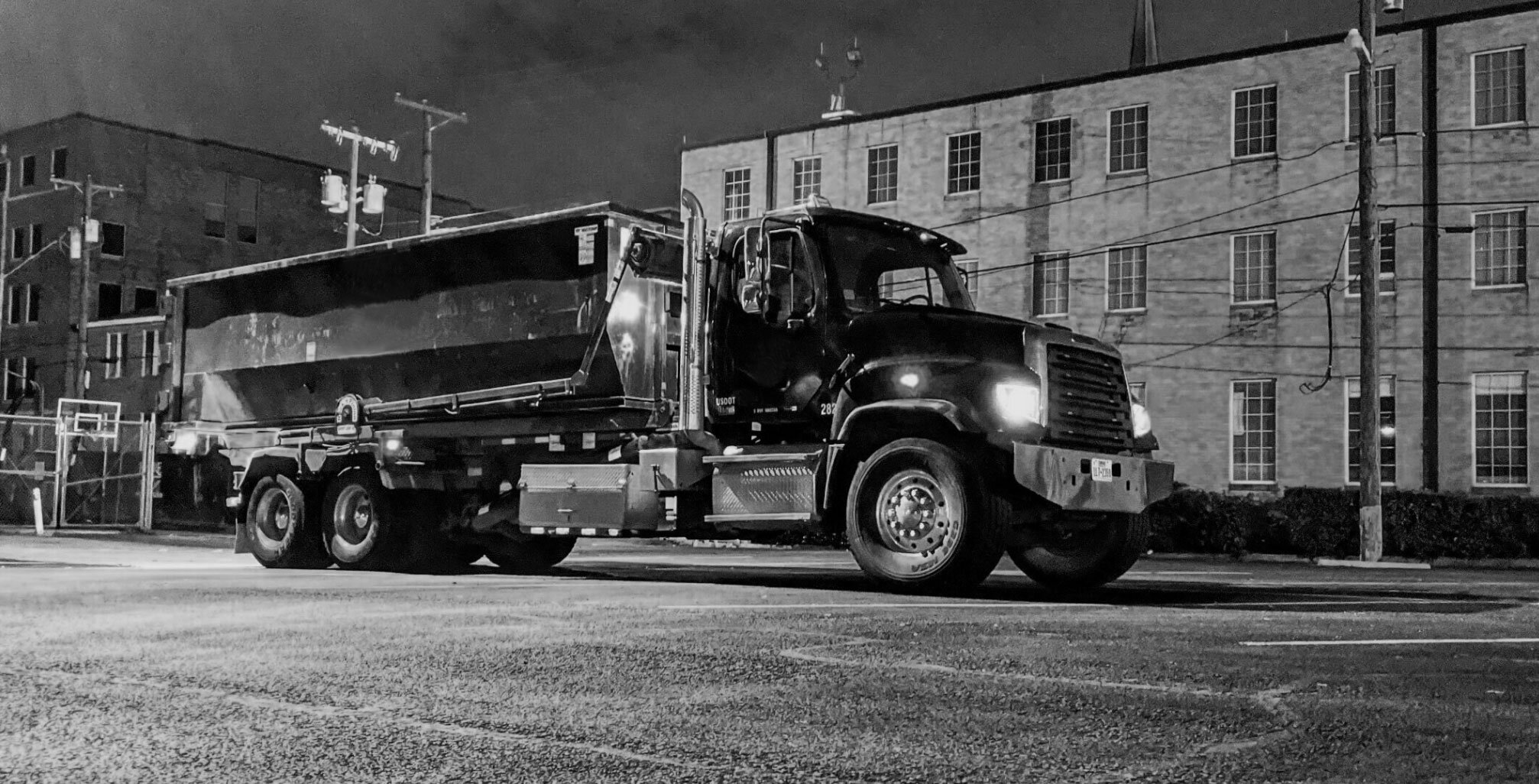
We Keep It Simple
The concept of renting a dumpster seems pretty simple. However, you must keep in mind; you are renting someone else's property just like renting a car or anything else. Here are some tips along with some FAQs to help you avoid additional costs and make the rental process as painless as possible.
Dumpster Delivery
Dumpsters come in all shapes and sizes and can be delivered by a variety of different trucks. Essentially it’s a flatbed, dump-style truck. Meaning, the dumpster sits on a modified flatbed truck. When the dumpster arrives to be delivered, the bed of the truck rises up into the air and the dumpster, which is secured by a heavy steel cable, is slowly lowered off the truck onto the ground.
It is your responsbility to make sure that there are no hazards like low power lines or tree branches that would prevent the delivery. Remember, the driver has more than likely never been to your house or property and relies on your information to make sure the delivery is possible.
Sizes
The most common sizes offered for roll-off, temporary or construction style dumpsters are 10 yard, 20 yard, 30 yard and 40 yard dumpsters. There are other sizes (12 yard, 15 yard, 25 yard dumpsters) but they are not very common.
Dumpster sizes are typically dictated by your geographic location... what city or market you're in. Certain markets, competitors and sometimes state laws will have an impact on what sizes are commonly available in your area.
Uses
Dumpsters can be used for many reasons. The two most popular uses are for general household materials and for construction debris. Some other uses include the following:
Tip:
The beds of the truck will often times require a clearance of 20
feet high or more in order to successfully allow gravity to lower
the dumpster and “slide” off the truck.Always make sure your driveway or delivery area is clear, wide and
long enough for the dumpster.It’s always a good idea to measure your area before placing the
order for the delivery.
Landscaping
Yard Cleanup
Concrete Removal
Food Waste Only
Roofing Shingles (Only)
Dirt Only
Mixed use compromised of two or more of
the previous materials being co-mingled
Rental Period
An average rental period is anywhere from 5 days to 14 days or more, included in the quoted price. The rental period is dependent upon several factors but two of the biggest influences would be the haulers inventory of dumpsters and how busy the hauler is at the time of your call. If you work with a small company that only has a handful of dumpsters, they might want a quick turn around on the dumpster so they can rent it again and again. Dumpsters are the haulers' life-blood and they need to keep them moving in order to make a profit.
Price
Just like any other product or service, dumpster driving is going to be different for every company. Pricing also varies greatly by geographic location nationally. There is a long list of factors that come into play, so here are a few of the main influencers:
Size of the Dumpster. The bigger, the more expensive
The Weight of the Contents going into the Dumpster.
Dumpster companies often have to pay the landfill or transfer station based on a price per ton model.The type of materials going into the Dumpster. This is one of the biggest influences on cost.
How far away you are from the company your are renting from or the facility where your dumpster will be emptied. Typically mileage and fuel costs will come into play, so the further away, the more expensive your dumpster can be.
You should always seek to work with a company who offers "flat rate" pricing. A flat rate is one charge for the entire service including, delivery, removal, rental, tonnage, etc (this excludes overweight, trip, and extension fees because they do not apply up-front). It is always best to work with a company that rolls all fees into one rate so it's more understandable for the customer and leaves less opportunity for extra or hidden fees to creep in.
A few examples of these "hidden fees" could be:
A company could charge a delivery fee PLUS a fee per ton PLUS a fee per day PLUS percentage on fuel and enviromental fee PLUS a franchise percentage fee PLUS taxes and sometimes PLUS a removal fee and/or a deposit.
Basically, unless you know how much your materials will weigh and take the time to calculate everything precisely, you won't know how much the dumpster costs until it is time for your invoice.
TYPES OF WASTE
organic and heavy debris
These materials are extremely heavy and not all dumpster companies will allow these materials in the dumpster due to the weight and potential hazards of hauling this type of debris. There are many companies that do allow these materials however, they may be segmented and treated differently which would mean the cost is different than normal debris and/or there may be restrictions on the size of dumpster allowed and commingling of various materials.
Be sure to check
with your dumpster provider before placing them in
your dumpster.
Concrete
Stone
Asphalt
Dirt
Sod
Brick
Block
Stumps
Logs
Yard Waste
Construction Waste
These materials are what is used to build a house or structure. Demolition or re-model are most commonly described for construction waste. This may or may not include hot water tanks, furnaces, or carpet.
Appliances are not considered construction waste. Be sure to check with your dumpster provider about these items specifically before placing them in your dumpster.
Plywood
Toilets
Bathtubs
Shower Stalls
Cabinets
Countertops
Boards
Appliances
are not
considered construction waste.
Wood
Drywall
Windows
Doors
Roofing Shingles
Tile
Household Waste
These are typically any materials that were placed inside the home or property AFTER the home was built.
*Special Note: Electronics, appliances, motor parts, and carpet are usually special considerations and you should be sure to check with your dumpster provider about these items specifically before placing them in your dumpster.
Electronics, appliances, motor parts, pallets, and carpet are NOT ALLOWED IN FRONT LOAD CONTAINERS
Clothes
Furniture
Toys
Desks
Chairs
Tables
Hazardous Material
There are some materials and items that can't go into most dumpsters. The following items are almost universally considered hazardous materials and should not be placed in your dumpster.
Car tires
Car batteries
Batteries
Oils
Paints
Refrigerant
Asbestos
Infectious Waste
Railroad ties
Pesticides
Thinners
Lacquers
Pain filters
Solvents
Oil filters
Medical Waste
Flammable or Toxic Liquids
Contaminated Absorbents
Pharmaceuticals
Inks
Resins
Adhesives
55 Gallon drums
*The above list is not comprehensive or complete.
You should check with your hauler for a complete list of items not allowed in the dumpster. Many municipalities have also enacted rules and laws against electronics, mattresses, pallets, appliances, and other items landing them on the prohibited items list.







